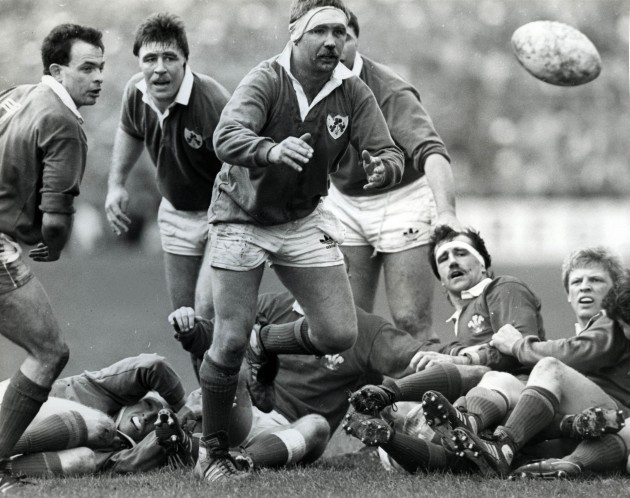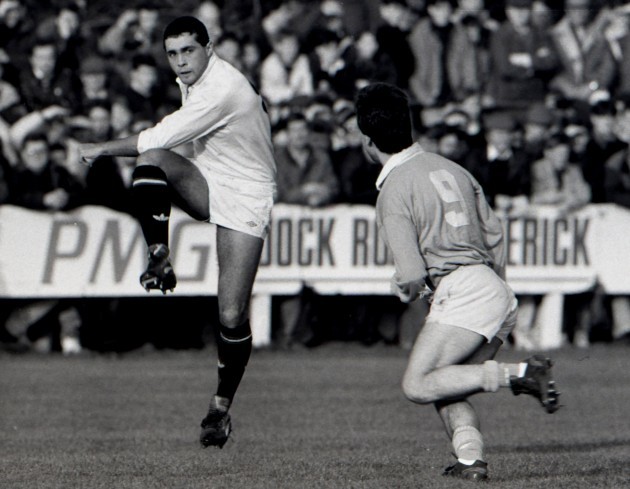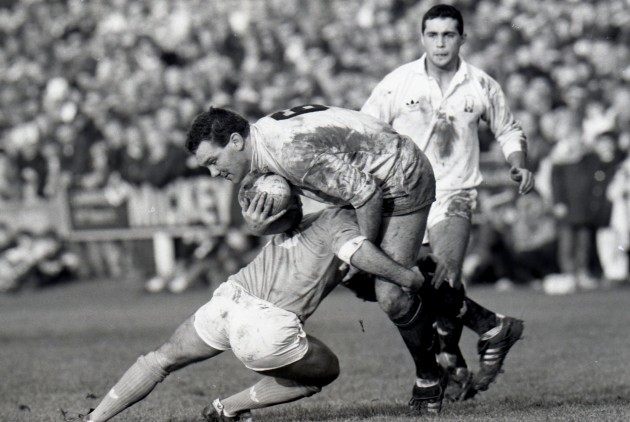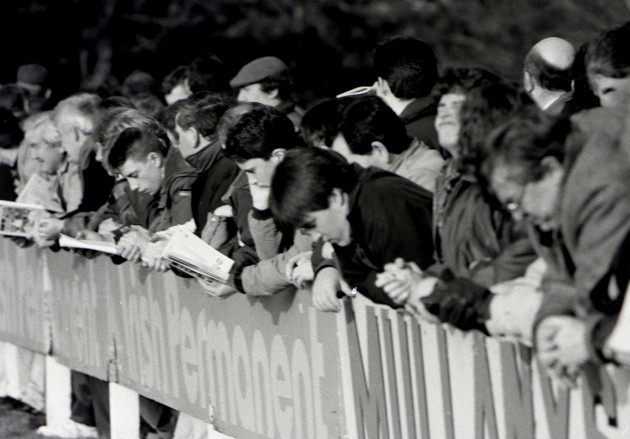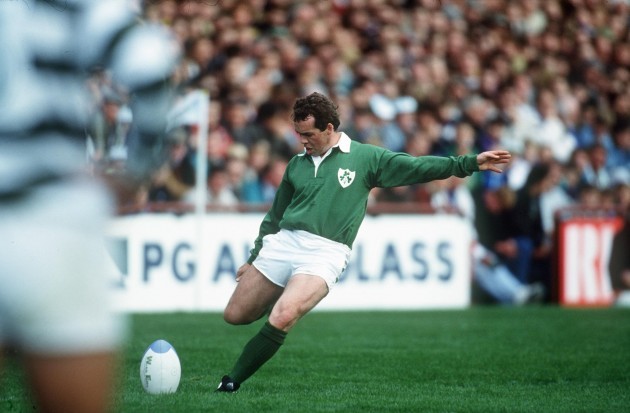IN SO MANY ways, the inaugural All-Ireland League had it all: a surprise winner, rugby as a metaphor for cross-border cooperation; the transition of a local hero into a world superstar; a reminder that the sport didn’t have to stay in hibernation 10 months-a-year.
But this isn’t just a story about how Ralph Keyes found greatness; it isn’t even about how Cork established a grip over just about every Irish sport in that brief period of time. It’s also about how Irish rugby dragged itself from the dark ages into modern life.
And like all the best stories, it starts in the pub. Kitty O’Shea’s to be precise, although the exact date has slipped Keyes’ mind. He was a young man then, working in insurance and pensions by day, working on his weaker foot in the evening. Cork Constitution was his second home. “You need somewhere to hang your hat,” he says, “and Con was dad’s club.”
Dad was Michael Keyes, a worker in Dunlop, the rubber manufacturer. One day in the ’60s, he got a call. Munster were playing South Africa that afternoon but out-half, Mick English, was struggling with a hamstring injury.
A replacement was needed, so a man in a trilby hat called to Dunlop’s front desk and asked for the manager. “Could we have Michael Keyes for a few hours?” he asked.
- For more great storytelling and analysis from our award-winning journalists, join the club at The42 Membership today. Click here to find out more >
They could. So, Keyes left the plant, raced home, got his boots; beat the traffic down to Musgrave Park, togging out in the old ramshackle changing room. If only the effort was worth it.
English – a British and Irish Lion, the man who stepped onto the Ireland team when Jack Kyle stepped off, decided, after all, that he was fit enough to face the Springboks. Michael Keyes didn’t even get to stay and watch the game, returning to the Dunlop factory floor.
A couple of decades later, Keyes had the chance to come in on the ground floor of a new idea: an All-Ireland League. “It had been talked about for years,” he says now. Often it was over pints, Wanderers’ Des Fitzgerald the proposer, Cork Con’s Donal Lenihan the seconder, Kitty O’Shea’s the debating chamber.
“We used to play these annual challenge matches against Wanderers,” Keyes recalls. “And because the quality of the matches were so good; we dubbed them the fourth inter-pro.”
But the following week, they reverted to drudgery. Way back then, the best players in Ireland were handicapped by a sporting calendar that had neither rhyme nor reason. Restricted to three inter-pros; a fourth game for their province against a touring side if they were lucky, internationals were frustratingly idle, Ireland playing just 53 Tests in the ‘80s.
That left the club scene to fill the vacuum, yet even here the calendar was blotted with empty weekends. Each province had their own league and cup; the status of the former dwarfed by the importance of the latter. “As far as we were concerned, the Munster Senior Cup was the biggest competition on the planet,” says Keyes.
It also was one of the few rugby competitions on the planet. Neither Super Rugby nor the Tri-Nations had been thought of; the inaugural World Cup didn’t kick off until 1987; France may have had their Top 14 but England didn’t have a league until 1987 while Ireland’s inter-provincial championship garnered interest in Ulster but nowhere else.
So Keyes, like every other Munster player, lived in a strange universe. The higher the level he played at, the smaller the crowd. “Sometimes there’d be just a few hundred at a Munster/Leinster game; but when we played a Cup match in Limerick, against Shannon, Garryowen or Young Munster, the place would be packed.”
He wasn’t to know it then but that experience would augur well for what was about to unfold.
WHEN CORK RULED THE WORLD
If you wanted to, you could look at Cork in 1990 as a separate entity from the rest of Ireland. Within its sporting orbit, the sun shone brightly enough to generate the heat and light that made every sporting fan in the county feel a glow denied to those beyond their boundaries.
The hurlers won the Liam MacCarthy, the footballers the Sam Maguire. In basketball, Neptune were All-Ireland league and cup champions in 1990, league winners again in 1991, Cup winners in ’92. Dave Barry swapped one jersey for another, winning an All-Ireland with Cork’s footballers in ’90, scoring an outstanding goal a year later for Cork City against Bayern Munich in the Uefa Cup.
Then there was Cork Con. When the first ever All-Ireland League kicked off in September 1990, no one gave them a prayer, pointing to how they had only just scraped into the top division, winning their final six Munster senior league games the season before to earn the invitation.
“The week before it started, I remember reading a double-page spread in The Sunday Tribune,” Keyes says. “On one page was this huge feature on Steve Smith (the Ballymena and Ireland hooker); on the other, Wanderers’ Paddy Kenny was interviewed.” Con, Garryowen and Shannon barely got a mention. “I wouldn’t say it was condescending,” says Keyes, “but it wasn’t the way it should have been.”
Eddie O’Sullivan remembers those pre-tournament predictions, too. “You wouldn’t have found anyone, and I mean anyone, who didn’t tip either Ballymena or Wanderers for that first title,” says the former Ireland coach. “You see Wanderers had been the dominant club in Leinster while Ulster in the middle of their 10-in-a-row winning streak in the inter-pro series. And Ballymena were Ulster Senior Cup and league double winners in both 1989 and 1990.”
But having won a Munster Senior Cup with Garryowen and having coached, by that stage, in both the Leinster and Connacht club scene, O’Sullivan had noted a distinct difference. “Things were way more tribal in Munster, way more intense,” he says. “Essentially, the Munster clubs were way more used to big occasions.”
It’d show in that opening campaign.
THE FINAL HURDLE
Nine runners went to post, by the final furlong, two were way out in front. Con may not have been fancied but they should have been. Five of their team had played for Munster against the All-Blacks in 1989; Paul McCarthy would go on to win five caps for Ireland, Len Dineen featured for Munster in their maiden Heineken Cup campaign.
Schooled in the Munster Senior Cup, they became specialists in winning tight matches; only a score separating them from five of their seven victims in that inaugural eight-game season. Their problem was that Garryowen were just as proficient in tight scenarios and by the time they got to the final game of the season, the Limerick side only needed a draw to be crowned champions.
It was fate, rather than any subtle marketing plan, that saw them face their only challengers, Cork Con, on the final day. “You couldn’t move in Dooradoyle,” says Keyes. “Biggest crowd I ever saw in the place,” echoes Dineen, a Limerick man who had migrated to Cork a couple of years earlier.
Keyes found his range early on, landing a penalty. Kenny Smith cancelled that out, the turning point coming in the second half when Con scored a pushover try, Bradley – the Cork Con captain – opting for a scrum rather than a kickable penalty. “Ralphie came up for the discussion,” Dineen says jokingly, “we sent him on his way.”
This is Keyes’ take on what happened: “Never mind him (Dineen); it was Michael’s call pure and simple,” he says, laughing. “The more cerebral analysts on the team were in the backs, not the donkeys up front.”
With that penalty try, and two kicks from Smith that rebounded off the woodwork, the donkeys had won the derby.
CROSSING BORDERS
If the inaugural eight-game league was a sprint – the journey home from Limerick to Ballintemple was a marathon. But when they eventually made it back to Temple Hill, after a dozen or so pit stops along the way, there were a couple of familiar faces waiting for them at the entrance: Cork GAA’s Dinny Allen and Tomás Mulcahy. “They’re great characters and it was just fabulous to see them there, showing their support,” says Keyes. “I’m not so sure that kind of thing would have happened five years earlier.”
Ireland had changed. Aside from sporting boundaries, that Cork team also crossed social and geographic ones. “Our team spirit was unbreakable,” says Dineen, “so much so that to this day, we’re all still close. I know the clichéd thing that is often said about rugby, but we weren’t just a white collar team. Some worked in insurance, some in the bank, some as plumbers, some as carpenters. No one asked what you did; no one judged you.”
Still, for Ireland internationals in that era, occupations would be listed beside each name in the match programme, except that is, when it came to certain Ulster players who were discreetly referred to as civil servants, a security policy to avoid alerting people to the fact that RUC men were journeying south of the border.
Come 1990/91, six teams, three from Leinster, a further three from Munster, were crisscrossing the border to play in Ireland’s first national league. “It was a brilliant thing,” said Paddy Johns, who made his debut for Ireland that season. “Seeing all these busses waiting at Portadown train station to transport fans from Garryowen, Shannon down to Dungannon was just marvellous.”
In those pre-Ceasefire days, when Northern Ireland didn’t have much of tourism industry, the influx was welcomed. “The trips north were brilliant,” says Dineen. “The craic; you remember that as much as the games.”
THE CROWDS
While the crowds were healthy in Dungannon and Ballymena; decent in Dublin and Cork, when it came to the Limerick derbies, they had to be seen to be believed. “Prior to the All-Ireland League, I was used to a couple of hundred for one of our club games,” says Connacht and Ireland’s Noel Mannion. “Then, whenever we played Shannon, Garryowen or Young Munster, it was jammers, week in, week out.”
The good word spread around the country. “We had this travel agent in the club,” says the former Greystones, Leinster, Ireland and Lions prop, Nick Popplewell. “Every week we played away, he booked out a train just for our supporters; a special to take us from the station in Greystones to whichever town or city we were playing in. For a while, the All-Ireland League was the only show in town.”
O’Sullivan tells a similar story from his time coaching Blackrock; Mannion from his final days as a player at Buccaneers. Limerick may have had the largest congregations but it was a broad church. “You remember Temple Hill being packed alright,” says Dineen. “Week after week.”
THE AIL: MAKERS OF A GREAT TEAM
Over time, the crowds found somewhere else to go. Professionalism arrived in 1995, the same year this tournament called the Heineken Cup kicked off.
Five years later, as Munster steered a path to Twickenham for the 1999/2000 final, a conversion had taken place. The long forgotten provincial scene suddenly felt shinier and new and the arrival in 2001/02 of the Celtic League guaranteed provinces a minimum 13 games per season.
As that competition put down roots, the AIL suffered. Players were contracted to the provinces, not the clubs. Crowds responded in kind. Munster were box-office; Ulster had always had a strong, independent identity while the failed attempt to kill off Connacht ensured no one would ever doubt their viability again.
“If you look at it rationally,” says Dineen, “that great Munster side of the Noughties was schooled in the AIL. The pack was largely Shannon’s. All the big Munster clubs contributed to it. The AIL definitely led to something special there.”
If you wanted, there are more dots you could connect. If the AIL was a finishing school for Munster; then provincial rugby was the last bit of education a player needed before going on to play for Ireland. “You can’t underestimate how important Munster’s rise was for Irish rugby,” O’Sullivan says. “They provided the backbone of the Ireland team from one to 10 – all we had to do was put some outside backs with them and we had a team.”
Not just that, but it turned out to be an extremely good one, too good for the Australians in ’02, for World Cup winners, England, in ’04, for South Africa a year later. Looking back now, it may seem a stretch to say all this stemmed from the creation of the AIL. But the competition served a purpose. Players grew up in it.
THE AIL: CREATOR OF A GREAT PLAYER
International success kept drifting away from Ralph Keyes like smoke. It was there for him to see and smell but was always impossible to grasp. In 1986 he made his debut against England ‘and then I sat on the bench about 20 times, in the days when replacements only got on if the starting player’s leg was hanging off’.
It was easier to remain patient when that starter was Paul Dean, a gentleman, an ’89 Lion, a cracking player. But when Dean got old, Brian Smith came in ….. from Australia. The Queenslander had already been capped six times by the Wallabies, featuring against Ireland in the ’87 World Cup.
Suddenly he was playing for them, Keyes overlooked again. So that 1990/91 season, watching Smith collect caps which would have meant so much more to him, motivated him to make his point with his local side. He was Con’s best player as they won the title and then, after Smith returned to Australia to sign professional terms with Sydney’s Balmain Tigers, Keyes finally had his chance.
He took it. Nine successful kicks against Zimbabwe in Ireland’s World Cup opener augured well for what was to come.
He’d get another six against Japan, four – plus a drop goal – against Scotland and then finally, on World Cup quarter-final day, he had the game of his life against the eventual champion Wallabies.
“Everyone tipped us to get stuffed,” he recalls. But another Cork Con man, Donal Lenihan, decoded the Australian line-out. Neil Francis, Lenihan’s second row partner, was equally good; Steve Smith threw perfectly and Keyes didn’t think twice about kicking for touch rather than infield. “We’d nothing to fear,” he said.
Then Gordon Hamilton scored, Keyes kicked a sideline conversion – and finished that World Cup as the tournament’s top scorer. He, and Ireland, came closer to defeating the winning Wallabies than anyone; indeed they came closer than any other Irish team to making a World Cup semi-final.
He was a genuine superstar in that tournament. The only problem was that his opposite number, Australia’s Michael Lynagh, was a hall of famer. He rubbed out Hamilton and Keyes’ work with just a couple of minutes left on the clock.
“Afterwards one of the Australians told us that the first thought that went through their mind after Gordon’s try was that they’d left their laundry into the dry cleaners and were worried they wouldn’t get it back for a few days,” says Keyes.
The concern soon disappeared. Lynagh scored; Keyes’ Indian Summer neared its end. Like every other rugby player, he got beaten by time.
Time also caught up on the AIL. While it was a box-office attraction throughout the ’90s, as the decade ended and the Millennium arrived, there was an alternative show for people to watch. First the league’s top players went to the provinces, then the crowds followed them.
Three decades on from that inaugural season, it is hard to imagine now how big a deal it once was. But that first year, it was better than anyone expected and for Dineen, for Keyes, for Cork Con, it was more than that. “The time of our lives,” says Dineen.
Who can argue?
- For more great storytelling and analysis from our award-winning journalists, join the club at The42 Membership today. Click here to find out more >

